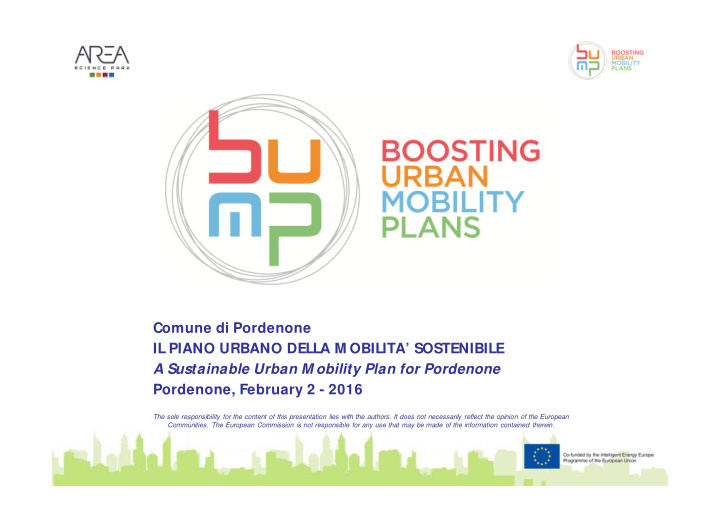



Comune di Pordenone IL PIANO URBANO DELLA M OBILITA’ SOSTENIBILE A Sustainable Urban M obility Plan for Pordenone Pordenone, February 2 - 2016 The sole responsibility for the content of this presentation lies with the authors. It does not necessarily reflect the opinion of the European Communities. The European Commission is not responsible for any use that may be made of the information contained therein.
The city Pordenone Population: 51.632 inhabitants
The city ● M ain territorial features Location: western part of the Friuli Venezia Giulia Region Territorial extension: 38,23 sqKm Population density: 1,345 inh,/ sqKm. Six neighbourhoods: Rorai-Cappuccini, Nord (including the Comina quarter), Centro, Torre, Borgomeduna, Sud (including Villanova and Vallenoncello quarters). Territorial features: plains with many green areas and two rivers Noncello (used to connect the city with the Adriatic Sea and Venice) and M eduna ● M ain economic activities Economy: traditionally a rural area with agriculture as a main sector, in the 19th century it becomes an industrialized area (textiles). After WW2 major industrialization with Lino Zanussi turning his company into the second largest manufacturer in Italy after FIAT with more than 13.000 employees in the 1960s. Pordenone becomes one of the richest and more active areas in Italy and Europe (sectors: carpentry, furniture, knife-making, textiles, engineering) until the 2007 crisis with many of the main employers (Ideal Standard, Electrolux) in the area closing down, partly counterbalanced by the multiplicity of sectors. ● M ain poles of attraction for flows of people and freight Permanent exhibition, university, old town, hospital, logistics terminal, M eduna shopping centre ● Crucial statistics Third largest city in the Region, after Trieste and Udine Population (on 01/ 01/ 2015): 51,632, of which 52.5% are women and 47.5% are men. Age distribution: majority of population between 40 and 60, with over 65s steadily increasing in the period 2002-2015 (very old active population). People aged 20-24 equal those aged 80-84. 15.5% of population has a foreign origin Car/ inhabitant ration: 68/ 100 (decreasing by 4.2% from 2004 to 2015)
The city
The SUM P ● Vision underpinning the plan Visione alla base del piano
The SUM P ● Vision underpinning the plan
The SUM P ● Vision underpinning the plan
Interventi porte ingressi / uscite alla Zona 30 di progetto del centro storico
CICLO RING: completamento e riconoscimento della rete ciclabile
CICLO RING: completamento e riconoscimento della rete ciclabile Piazzale Duca D’Aosta
CICLO RING: completamento e riconoscimento della rete ciclabile Largo San Giovanni
CICLO RING: completamento e riconoscimento della rete ciclabile Largo San Giacomo
Intermodal nodes: Valorization of the freight logistics centre and city-logistic
The SUM P M ain implementation features ● Context analysis
The SUM P M ain implementation features ● Context analysis
The SUM P M ain implementation features ● Context analysis
The SUM P M ain implementation features ● Context analysis
The SUM P ● Short-term goals
The SUM P ● M id-term goals
The SUM P ● Long-term strategic objectives
The SUM P ● Specific indicators Gli indicatori specifici
The SUM P M ain implementation features ● M easures addressed to secure horizontal and vertical integration and participation of all main stakeholders ●
The SUM P M ain implementation features ● M easures addressed to secure horizontal and vertical integration and participation of all main stakeholders
The SUM P M ain implementation features ● M easures and actions chosen in the SUM P to support a balanced development of all transport modes Along with infrastructural measures, a number of intangible actions are envisaged to foster the shifting of the modal split towards more sustainable ratios. Harmonizing the city’s times to make public transport more efficient and effective, increasing the number of users and their fidelization ; Information portals and APPs for smartphones: remote video monitoring to foster access to the city of people using car-sharing or car-pooling; possibility to use bus lanes for cars carrying the maximum number of passengers; cheaper car parks for those using car-sharing/ pooling and park and ride systems combined with bike-sharing Granting a more rational and profitable management of parking areas through more efficient payment schemes
The SUM P M ain implementation features ● M onitoring and evaluation procedures Each action (infrastructural and intangible) is monitored through a set of indicators, easily measurable on-site by the mobility office, as fuel consumption, reduction of pollutants, vehicle counting
Thank you for your attention! M assimiliano M anchiaro Ufficio M obilità COM UNE DI PORDENONE http:/ / www.comune.pordenone.it/ it
Recommend
More recommend